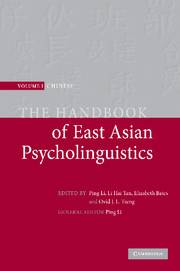Book contents
- Frontmatter
- Contents
- List of figures
- Notes on contributors
- Preface
- Introduction: new frontiers in Chinese psycholinguistics
- Part I Language acquisition
- Part II Language processing
- 14 Word-form encoding in Chinese speech production
- 15 Effects of semantic radical consistency and combinability on Chinese character processing
- 16 Eye movement in Chinese reading: basic processes and crosslinguistic differences
- 17 The Chinese character in psycholinguistic research: form, structure, and the reader
- 18 Perception and production of Mandarin Chinese tones
- 19 Phonological mediation in visual word recognition in English and Chinese
- 20 Reading Chinese characters: orthography, phonology, meaning, and the Lexical Constituency Model
- 21 Processing of characters by native Chinese readers
- 22 L2 acquisition and processing of Mandarin tones
- 23 The comprehension of coreference in Chinese discourse
- 24 Lexical ambiguity resolution in Chinese sentence processing
- Part III Language and the brain
- Epilogue: a tribute to Elizabeth Bates
- References
- Name index
- Subject index
22 - L2 acquisition and processing of Mandarin tones
Published online by Cambridge University Press: 05 June 2012
- Frontmatter
- Contents
- List of figures
- Notes on contributors
- Preface
- Introduction: new frontiers in Chinese psycholinguistics
- Part I Language acquisition
- Part II Language processing
- 14 Word-form encoding in Chinese speech production
- 15 Effects of semantic radical consistency and combinability on Chinese character processing
- 16 Eye movement in Chinese reading: basic processes and crosslinguistic differences
- 17 The Chinese character in psycholinguistic research: form, structure, and the reader
- 18 Perception and production of Mandarin Chinese tones
- 19 Phonological mediation in visual word recognition in English and Chinese
- 20 Reading Chinese characters: orthography, phonology, meaning, and the Lexical Constituency Model
- 21 Processing of characters by native Chinese readers
- 22 L2 acquisition and processing of Mandarin tones
- 23 The comprehension of coreference in Chinese discourse
- 24 Lexical ambiguity resolution in Chinese sentence processing
- Part III Language and the brain
- Epilogue: a tribute to Elizabeth Bates
- References
- Name index
- Subject index
Summary
Introduction
Mandarin tones are manifested physically by different fundamental frequency (F0) values with F0 height and F0 contour as the primary acoustic parameters (Liu, 1924; Howie, 1976; Wu, 1986). In addition, amplitude and temporal properties such as overall duration and Turning Point are also effective phonetic correlates of the tones (Lin, 1965; Chuang et al., 1971; Moore & Jongman, 1997). Studies in the perceptual domain have shown that various acoustic cues are functionally integrated when Mandarin speakers identify the tones (Gandour, 1984; Massaro, Cohen & Tseng, 1985; Gårding et al., 1986; Blicher, Diehl & Cohen, 1990; Shen & Lin, 1991; Moore & Jongman, 1997). The hemispheric processing of Mandarin tones for native speakers is lateralized in the left hemisphere, suggesting that tones are processed as linguistic units, just like segmental properties (Hsieh et al., 2001; Wang, Jongman & Sereno, 2001).
These results about the processing of Mandarin tones for native speakers raise the question as to whether non-native speakers process tones auditorily (i.e. based on innate psychoacoustic mechanisms) or linguistically (i.e. resulting from language-specific experience). Indeed, for speakers whose native language is nontonal, tone has presented great difficulty, since the functional association between the F0 characteristics and the segmental structure is unfamiliar to them (e.g. Kiriloff, 1969; Bluhme & Burr, 1971; Shen, 1989). A number of crosslinguistic studies have been conducted to examine if and how nontonal speakers process the tones differently, how they improve the processing of the tones as a result of learning, and how this learning is instantiated in the brain.
- Type
- Chapter
- Information
- The Handbook of East Asian Psycholinguistics , pp. 250 - 256Publisher: Cambridge University PressPrint publication year: 2006
- 12
- Cited by



